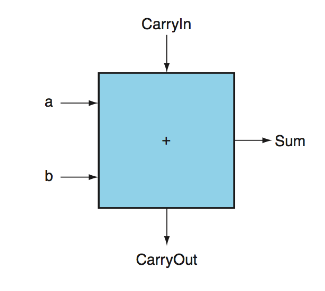## Constructing an # ALU --- CS 130 // 2021-11-10 <!--=====================================================================--> ## Administrivia - Assignment 4 + Due tomorrow night (due to my error) - <!-- .element: class="fragment"--> Assignment 5 is released + Will talk about it at the end of class today <!----------------------------------> <!-- .slide: data-background-iframe="/teaching/2021f/cs130/assignments/assignment-4/index/" data-background-interactive --> <!--=====================================================================--> # Questions ## ...about anything? <!--=====================================================================--> # ALU <!-- .slide: data-background="#004477" --> <!--=====================================================================--> ## The ALU - What does ALU stand for? + Arithmetic Logic Unit - <!-- .element: class="fragment"--> What does an ALU do? + Does all the logical and arithmetic operations of the CPU <!--=====================================================================--> ## Basic ALU - The simplest ALU conceivable is one that only operates on two 1-bit inputs and can perform only two operations: **AND** and **OR** ```py def basic_alu(a, b, op): if op == 0: return (a and b) else: return (a or b) ``` - <!-- .element: class="fragment"--> Let's implement this in Logisim! <!--=====================================================================--> ## Including Addition as an Op - For Assignment 4, you were implementing a full adder like the one below:  <!----------------------------------> ## Including Addition as an Op - We can change our ALU so that when `op = 2`, we will do addition instead of AND or OR ```py def basic_alu(a, b, c_in, op): if op == 0: return (a and b) elif op == 1: return (a or b) elif op == 2: return (a + b + c_in) # 2-bits, c_out and result ``` - <!-- .element: class="fragment"--> Let's implement this in Logisim! <!--=====================================================================--> # Multi-Bit ALU <!-- .slide: data-background="#004477" --> <!--=====================================================================--> ## Including Other Operations - How can we include **subtraction** as an op? - <!-- .element: class="fragment"--> How can we include **NAND** as an op? <!----------------------------------> ## Including Other Operations - This version of the 1-bit ALU has inputs: + `$a$`, `$b$`, `$a_\text{inv}$`, `$b_\text{inv}$`, `$c_\text{in}$`, and `$\text{op}$` - <!-- .element: class="fragment"--> What are each of the inputs if I want to compute: + <!-- .element: class="fragment"--> `$a$` plus `$b$` + <!-- .element: class="fragment"--> `$a$` minus `$b$` + <!-- .element: class="fragment"--> `$a$` AND `$b$` + <!-- .element: class="fragment"--> `$a$` NAND `$b$` + <!-- .element: class="fragment"--> NOT `$a$` <!--=====================================================================--> <!-- .slide: data-background="#004477" --> # `slt`